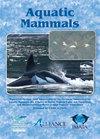印度安达曼群岛儒艮(Dugong dugon)种群大小动态及自然史观察
IF 0.9
4区 生物学
Q4 MARINE & FRESHWATER BIOLOGY
引用次数: 1
摘要
在过去的四十年里,儒艮(dugong dugon)聚集在印度安达曼群岛地理孤立、广阔的海景上的报道很少。2004年的印度洋海啸、狩猎、海岸开发和栖息地丧失是安达曼群岛儒艮社会系统发生变化的主要原因。我们的长期监测研究(2017年至2022年)揭示了儒艮聚集行为的变化趋势。在一项包容性的合作努力中,我们使用两种方法让多个利益相关者参与进来:(1)创建一个空间分布的公民科学网络,目标是航海机构——渔民、林业部门、SCUBA潜水员和国防机构(印度海军和印度海岸警卫队);(2)对渔民进行标准化问卷调查。我们的方法报告了来自安达曼群岛的63只儒艮群体目击事件。渔民报告了73.01%的目击事件,其次是国防机构(20.63%)、林业部门(3.18%)和SCUBA潜水员(3.18%。由7至13只个体组成的大型畜群包括“成年-小牛”组合,更多的成年畜群伴随着2至3只小牛。据报道,95%以上的群体发生在资源集中的有遮蔽的沿海水域(大型海草草地)。此外,我们还提供了来自Jarawa部落保护区和北哨兵岛等数据不足地区的新儒艮出现报告,以及来自小安达曼的儒艮发生报告,据推测,2004年海啸后,小安达曼地区的儒艮种群在当地灭绝。这些发现强烈主张多个利益相关者的参与,作为监测安达曼群岛和尼科巴群岛等大型海景中儒艮分布和种群的一种具有成本效益的方法。此外,这种方法对于提高当地利益攸关方对儒艮等大型海洋哺乳动物的保护和管理的认识至关重要。本文章由计算机程序翻译,如有差异,请以英文原文为准。
Herd Size Dynamics and Observations on the Natural History of Dugongs (Dugong dugon) in the Andaman Islands, India
In the last four decades, dugong (Dugong dugon) aggregations have been rarely reported from the geographically isolated, vast seascape of the Andaman Islands, India. The Indian Ocean tsunami of 2004, hunting, coastal development, and habitat loss are the major causes of this change in the social system of dugongs in the Andaman Islands. Our long-term monitoring study (2017 to 2022) reveals a changing trend in aggregating behaviour of dugongs. In an inclusive, collaborative effort, we engaged multiple stakeholders using two approaches: (1) creating a spatially spread citizen science network targeting sea-faring agencies—the fishers, forest department, SCUBA divers, and defence bodies (Indian Navy and Indian Coast Guard); and (2) conducting standardized questionnaire surveys (UNEP/CMS) with fishers. Our approach yielded reports of 63 herd sightings of dugongs from the Andaman archipelago. The fishers reported 73.01% of the sightings, followed by the defence bodies (20.63%), forest department (3.18%), and SCUBA divers (3.18%). Smaller herds in our study comprised three to six individuals, with a social structure of “adults only” and “adult–calf.” The larger herds of seven to 13 individuals included an “adult–calf” combination with a greater number of adults accompanying two to three calves. More than 95% of these herd occurrences were reported from sheltered, coastal waters with resource concentrations (large seagrass meadows). Further, we present novel dugong occurrence reports from data-deficient regions like the Jarawa Tribal Reserve and the North Sentinel Island, along with dugong occurrences from Little Andaman, where the population was speculated to be locally extinct after the 2004 tsunami. These findings strongly advocate the involvement of multiple stakeholders as a cost-effective approach to monitoring the distribution and population of dugongs in larger seascapes like the Andaman and Nicobar Islands. Moreover, such an approach would be critical for sensitizing the local stakeholders regarding the conservation and management of large marine mammals such as dugongs.
求助全文
通过发布文献求助,成功后即可免费获取论文全文。
去求助
来源期刊

Aquatic Mammals
MARINE & FRESHWATER BIOLOGY-ZOOLOGY
CiteScore
1.60
自引率
16.70%
发文量
99
审稿时长
>12 weeks
期刊介绍:
Aquatic Mammals is a peer-reviewed journal sponsored by the European Association for Aquatic Mammals (EAAM), the Alliance of Marine Mammal Parks and Aquariums (AMMPA), and the International Marine Animal Trainers’ Association (IMATA). Aquatic Mammals publishes articles related to marine mammals (whales, dolphins, seals, fur seals, sea lions, walrus, dugongs, manatees, sea otters, and polar bears). Topics of publication on both captive animals and wild marine mammals include aspects of husbandry; behavior; conservation; veterinary medicine; anatomy; physiology; training; population trends; and the effects of pollution, climate change, and noise.
 求助内容:
求助内容: 应助结果提醒方式:
应助结果提醒方式:


